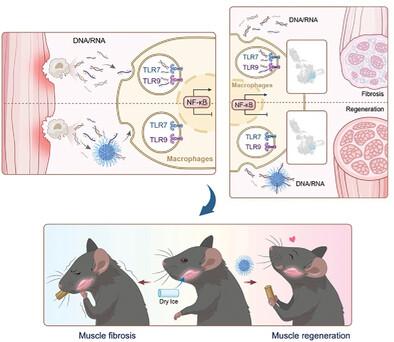当前位置:
X-MOL 学术
›
Adv. Mater.
›
论文详情
Our official English website, www.x-mol.net, welcomes your
feedback! (Note: you will need to create a separate account there.)
Nanomaterial‐Mediated Reprogramming of Macrophages to Inhibit Refractory Muscle Fibrosis
Advanced Materials ( IF 27.4 ) Pub Date : 2024-11-16 , DOI: 10.1002/adma.202410368 Xu Cheng, Hao Sui, Fangman Chen, Chenghao Li, Meijun Du, Shiming Zhang, Jiali Chen, Jinfeng Dou, Yixuan Huang, Xiaochun Xie, Chuanxu Cheng, Renjie Yang, Chao Yang, Bing Shi, Dan Shao, Kam W. Leong, Hanyao Huang
Advanced Materials ( IF 27.4 ) Pub Date : 2024-11-16 , DOI: 10.1002/adma.202410368 Xu Cheng, Hao Sui, Fangman Chen, Chenghao Li, Meijun Du, Shiming Zhang, Jiali Chen, Jinfeng Dou, Yixuan Huang, Xiaochun Xie, Chuanxu Cheng, Renjie Yang, Chao Yang, Bing Shi, Dan Shao, Kam W. Leong, Hanyao Huang

|
Orofacial muscles are particularly prone to refractory fibrosis after injury, leading to a negative effect on the patient's quality of life and limited therapeutic options. Gaining insights into innate inflammatory response‐fibrogenesis homeostasis can aid in the development of new therapeutic strategies for muscle fibrosis. In this study, the crucial role of macrophages is identified in the regulation of orofacial muscle fibrogenesis after injury. Hypothesizing that orchestrating macrophage polarization and functions will be beneficial for fibrosis treatment, nanomaterials are engineered with polyethylenimine functionalization to regulate the macrophage phenotype by capturing negatively charged cell‐free nucleic acids (cfNAs). This cationic nanomaterial reduces macrophage‐related inflammation in vitr and demonstrates excellent efficacy in preventing orofacial muscle fibrosis in vivo. Single‐cell RNA sequencing reveals that the cationic nanomaterial reduces the proportion of profibrotic Gal3+ macrophages through the cfNA‐mediated TLR7/9‐NF‐κB signaling pathway, resulting in a shift in profibrotic fibro‐adipogenic progenitors (FAPs) from the matrix‐producing Fabp4+ subcluster to the matrix‐degrading Igf1+ subcluster. The study highlights a strategy to target innate inflammatory response‐fibrogenesis homeostasis and suggests that cationic nanomaterials can be exploited for treating refractory fibrosis.
中文翻译:

纳米材料介导的巨噬细胞重编程抑制难治性肌肉纤维化
口面部肌肉在受伤后特别容易发生难治性纤维化,对患者的生活质量产生负面影响,治疗选择有限。深入了解先天性炎症反应-纤维化发生稳态有助于开发肌肉纤维化的新治疗策略。在这项研究中,确定了巨噬细胞在损伤后口面部肌纤维化调节中的关键作用。假设协调巨噬细胞极化和功能将有利于纤维化治疗,纳米材料采用聚乙烯亚胺功能化设计,通过捕获带负电荷的无细胞核酸 (cfNA) 来调节巨噬细胞表型。这种阳离子纳米材料可在体外减少巨噬细胞相关炎症,并在体内预防口面部肌肉纤维化方面表现出优异的疗效。单细胞 RNA 测序显示,阳离子纳米材料通过 cfNA 介导的 TLR7/9-NF-κB 信号通路降低促纤维化 Gal3+ 巨噬细胞的比例,导致促纤维化成脂祖细胞 (FAP) 从产生基质的 Fabp4+ 亚簇转移到基质降解的 Igf1+ 亚簇。该研究强调了一种靶向先天性炎症反应-纤维化发生稳态的策略,并表明阳离子纳米材料可用于治疗难治性纤维化。
更新日期:2024-11-16
中文翻译:

纳米材料介导的巨噬细胞重编程抑制难治性肌肉纤维化
口面部肌肉在受伤后特别容易发生难治性纤维化,对患者的生活质量产生负面影响,治疗选择有限。深入了解先天性炎症反应-纤维化发生稳态有助于开发肌肉纤维化的新治疗策略。在这项研究中,确定了巨噬细胞在损伤后口面部肌纤维化调节中的关键作用。假设协调巨噬细胞极化和功能将有利于纤维化治疗,纳米材料采用聚乙烯亚胺功能化设计,通过捕获带负电荷的无细胞核酸 (cfNA) 来调节巨噬细胞表型。这种阳离子纳米材料可在体外减少巨噬细胞相关炎症,并在体内预防口面部肌肉纤维化方面表现出优异的疗效。单细胞 RNA 测序显示,阳离子纳米材料通过 cfNA 介导的 TLR7/9-NF-κB 信号通路降低促纤维化 Gal3+ 巨噬细胞的比例,导致促纤维化成脂祖细胞 (FAP) 从产生基质的 Fabp4+ 亚簇转移到基质降解的 Igf1+ 亚簇。该研究强调了一种靶向先天性炎症反应-纤维化发生稳态的策略,并表明阳离子纳米材料可用于治疗难治性纤维化。


















































 京公网安备 11010802027423号
京公网安备 11010802027423号